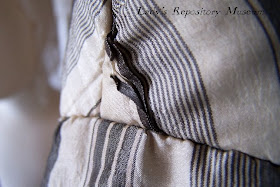 This mid 1840 daguerreotype shows the Dennis Brothers and their sister quietly figuring a cypher on their slate. This is an English Dag, but plaids and stripes were just as en vogue here in America. At the in between time between being young enough for an all out dress & leggings, and old enough for a miniature version of their father's suit, boys wore what is called a tunic over breeches. This was a close fitting top with either long or short sleeves, with an attached band of skirting that hung about half way down between the waist and knees. Both types can be seen above~ both straight flat front, and with a front that is gathered up into a yoke just under the collar bone, like alot of the dresses we see from this period.
This mid 1840 daguerreotype shows the Dennis Brothers and their sister quietly figuring a cypher on their slate. This is an English Dag, but plaids and stripes were just as en vogue here in America. At the in between time between being young enough for an all out dress & leggings, and old enough for a miniature version of their father's suit, boys wore what is called a tunic over breeches. This was a close fitting top with either long or short sleeves, with an attached band of skirting that hung about half way down between the waist and knees. Both types can be seen above~ both straight flat front, and with a front that is gathered up into a yoke just under the collar bone, like alot of the dresses we see from this period.


 This is an American boy~ wish I would have been standing there beside him! He wears his tunic with long breeches that have stirrups attached to the bottoms to keep them from riding up
This is an American boy~ wish I would have been standing there beside him! He wears his tunic with long breeches that have stirrups attached to the bottoms to keep them from riding up Our Mother's of past didn't waste a drop of anything. This closeup is the top shoulder seam~ see how the silk has been pieces together to fit~ I think it is rather comical that this small triangular piece was stitched together backwards....I mean~ look closely and you will see the seam allowance is on the OUTSIDE...on the right side of the fabric showing. I bet who ever made this was NOT happy when they realized what they had done.... I love little imperfections like this
Our Mother's of past didn't waste a drop of anything. This closeup is the top shoulder seam~ see how the silk has been pieces together to fit~ I think it is rather comical that this small triangular piece was stitched together backwards....I mean~ look closely and you will see the seam allowance is on the OUTSIDE...on the right side of the fabric showing. I bet who ever made this was NOT happy when they realized what they had done.... I love little imperfections like this On this view you can see on the right hand side, where the silk has been pieced~ careful to match the large black solid stripe, not so much the thin ones~ it took much extra fabric to match the pattern in stripes and large prints, and it is this reason why they were commonly used for upper class clothing, and likely not to be unpicked and remade into something else later on down the line
On this view you can see on the right hand side, where the silk has been pieced~ careful to match the large black solid stripe, not so much the thin ones~ it took much extra fabric to match the pattern in stripes and large prints, and it is this reason why they were commonly used for upper class clothing, and likely not to be unpicked and remade into something else later on down the line
This is a closer view of the false collar. The velvet is actually carefully pieced from 8 different little scraps. It has been layed over the silk, and carefully stitched on, then the whole neck has been bound over in matching stripe silk. It must have been THE latest fashion, an important trim to add, why not just leave it plain? Velvet like this, showed a person the wearer had status
 In this view of the coarse lining you can see little white tick marks at regular intervals~ these are actually the teeny stitched used to tack the wadding to the lining to keep it from bunching. This being silk, it has never been washed~ never would have been washed either. Silks were just only spot cleaned...can you imagine the look on Great Great Great Great Grandmothers face to see a washing machine of today?
In this view of the coarse lining you can see little white tick marks at regular intervals~ these are actually the teeny stitched used to tack the wadding to the lining to keep it from bunching. This being silk, it has never been washed~ never would have been washed either. Silks were just only spot cleaned...can you imagine the look on Great Great Great Great Grandmothers face to see a washing machine of today?
wow, this is beautiful! thanks for the lesson, as always :)
ReplyDelete